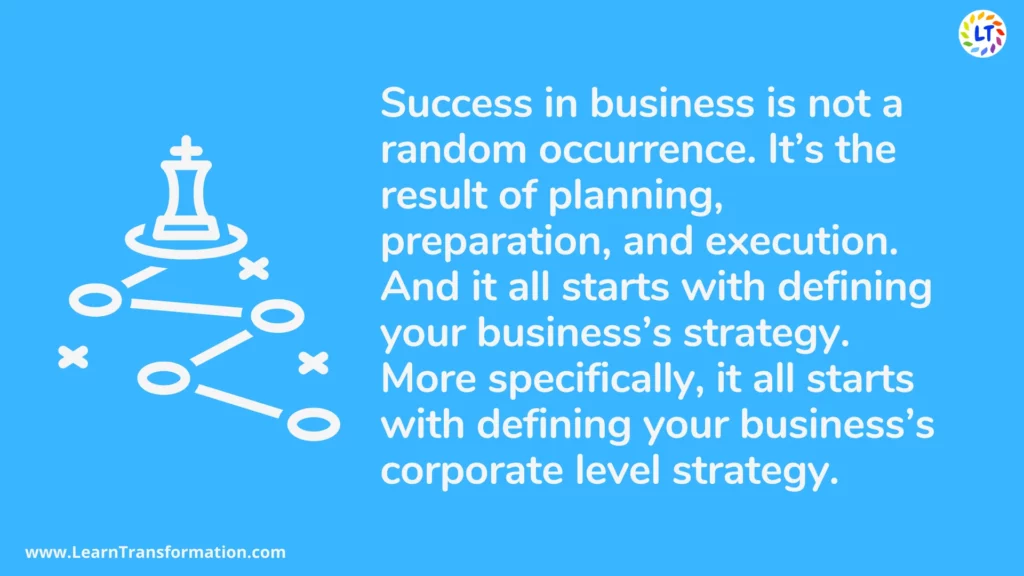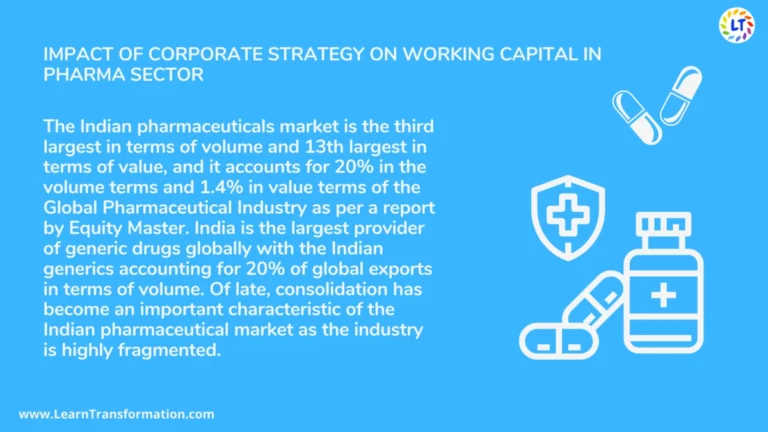A vision without a strategy remains an illusion.
Lee Bolman.
Success in business is not a random occurrence. It’s the result of planning, preparation, and execution. And it all starts with defining your business’s strategy. More specifically, it all starts with defining your business’s corporate level strategy.
What is Corporate Strategy?
Corporate strategy is the top of the planning pyramid. So, It is the main purpose of your business. So, Think of corporate level strategy as the destination toward which your business is moving. Thus, That destination affects all the strategies and decisions in every other part of your business.
So, for example, if your business has reached market saturation and you need to diversify to survive, your corporate-level strategy would be to spread to new markets. That becomes the guiding force for everything your business does from now on.
What is Working Capital Management ?
Each year, PwC UK reviews the financial performance of the largest global listed companies, assessing their working capital performance and related key indicators. Moreover, In this year’s report, we have continued to review five-year trends (2014 – 2018). And reflected on the advent of digital and its potential for creating value through improved working Capital management.
Globally, this research has revealed an absolute increase in net working capital (NWC) of €360bn in 2018 (up 9.4% on 2017). In relative terms, however, NWC days have improved for the first time in five years. So, The increase in NWC was offset by a 9.6% increase in revenue from the previous year. Resulting in a small decrease in NWC Days to 47.5.
In 2016 and 2017 working capital studies. We highlighted a trend of companies maintaining working capital performance at the expense of their suppliers. And noted that this approach would not be sustainable in the long term.
Working capital management is a business tool that helps companies effectively make use of current assets. Helping companies to maintain sufficient cash flow to meet short-term goals and obligations. By effectively managing working capital, companies can free up cash that would otherwise be trapped on their balance sheets. As a result, they may be able to reduce the need for external borrowing, expand their businesses, fund mergers or acquisitions, or invest in R&D.
Check this: 21 Best Digital Transformation Books

What is the Impact for Corporate Strategy on Working Capital in the Pharma Sector?
The Indian pharmaceuticals market is the third largest in terms of volume and 13th largest in terms of value, and it accounts for 20% in the volume terms and 1.4% in value terms of the Global Pharmaceutical Industry as per a report by Equity Master. India is the largest provider of generic drugs globally with the Indian generics accounting for 20% of global exports in terms of volume. Of late, consolidation has become an important characteristic of the Indian pharmaceutical market as the industry is highly fragmented.
Research Methodology
The present study is based on secondary data collected from a secondary source (published annual report) named “CIPLA Ltd. Then various issues of magazines and journals, working papers, and newspapers were also access for the relevant and covering the period from 2012–2013 to 2016–2017 (5 years). As a part of a study designed to evaluate the profitability and working capital management of CIPLA Ltd. Hence, Based on the following statistical tools: Summary statistics, correlation analysis, and t-test.
Better management of working capital could help firms get a better return rather than just driving top-line growth. So, Let’s list these on points for your better understanding my dear leaders!
Also Read: Logistics: The Backbone of Supply Chain Management
Leader’s Tip
To integrate corporate strategy with business goals, clearly describe the organization’s vision, mission, and objectives.
- Pharmaceutical companies have long been the envy of other industries. Given their strong balance sheets, high operating margins, and access to cash.
- As a result of these competitive advantages, members of the industry have historically paid little attention to releasing cash from their working capital. Which is commonly defined as the difference between a company’s current assets and its current liabilities.
- In the past, pharmaceutical companies were willing to operate with high levels of inventory and readily dealt with the related costs. As they did not want to run the risk of disrupting the delivery of medicines and missing a profitable sale.
- As a result, companies placed little emphasis on pursuing best practices in forecasting or other ways to wring greater returns from assets and investments that could free up cash.
- As followers of the pharmaceutical industry know, times are quickly changing. The industry faces significant challenges in different areas. Related to patent expirations, pricing and regulatory pressures, thin late-stage pipelines, shifting demographics, and efficacy issues.
- Faced with these challenges, members of the industry are now seeking to preserve the value they have created. While at the same time executing new transformational strategies to create value.
- Although much of the focus in recent years has been on the industry’s cost-cutting measures. The active management of working capital is increasingly becoming a key element of this transformative effort. (source= dcatvci.org)
Industry Performance
In analysing the working capital performance of 17 industries. The PwC report shows that 11 out of 17 sectors have improved their working capital performance since 2016 and achieved an improvement in 2017. Rankings from best performance were: energy & utilities; industrial manufacturing; retail; transportation and logistics; forest, paper, and packaging; healthcare; chemicals; engineering & construction; metals & mining; aerospace and defence; and consumer.
Leader’s Tip
Assess and change the corporate strategy on a regular basis to respond to changing market conditions and exploit new opportunities.
Traditionally, investors, academicians and research scholars were focusing on long term corporate finance decisions such as company valuation, dividends and capital structure. Importantly, the recent trend in corporate finance research is to focus on working capital practices. Thus, the current study sought to examine the impact of WCM on the financial performance of Indian pharmaceutical companies. Which has been neglected by researchers. Moreover, this study aimed to analyze working capital among small, medium and large firms.
Learn Transformation is here with a mission to transform their leaders to cope up with the VUCA World.
FAQs
What is working capital management and its types?
Working capital management is a business tool that helps companies effectively make use of current assets, helping companies to maintain sufficient cash flow to meet short term goals and obligations. By effectively managing working capital, companies can free up cash that would otherwise be trapped on their balance sheets. As a result, they may be able to reduce the need for external borrowing, expand their businesses, fund mergers or acquisitions, or invest in R&D.
What is an example of a corporate strategy?
For example, if your business has reached market saturation and you need to diversify to survive, your corporate level strategy would be to spread to new markets.
Key Takeaways
- Analysing the external environment, recognising strengths and weaknesses, and aligning resources to meet strategic objectives are all part of effective corporate strategy.
- Working capital management is critical in the pharmaceutical industry to provide optimal cash flow, efficient inventory management, and prompt supplier payment.
- Effective working capital management can contribute to higher profitability, liquidity, and competitiveness in the pharmaceutical industry.

